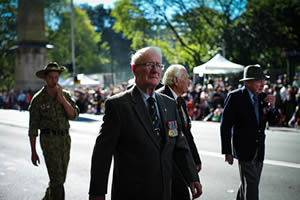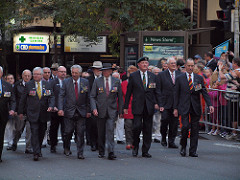English Stage 1
Overview

Sydney 2015 Anzac Day March
Students explore characters and their perspectives of Anzac Day through the text Anzac Day Parade by Glenda Kane and Lisa Allen. Students compose a description of the Anzac Day parade from the point of view of an onlooker, which includes a personal response.
Teaching and learning activities

Anzac Day Parade, Sydney, 2013
Anzac Day Parade by Glenda Kane and Lisa Allen
This story provides a poignant look at war through the eyes of a former member of the 18th Battalion. It takes place on Anzac Day, when an elderly man and a young boy meet. The young boy is wide-eyed and wanting to hear the glories of war and death; the elderly man is quietly sad to remember the reality of what was faced.
-
Read the story and discuss personal responses to the text. How did the story make you feel? Did you share the same feelings as your classmates? Why do we have different reactions/responses to stories?
-
How was the story told? Why did the characters share a different perspective?
-
Discuss how both characters have been portrayed. What has the author done to help us understand these characters?
-
Encourage students to make connections to the character and events.
-
Compose a description of the Anzac Day parade from the point of view of an onlooker. Include a personal response—how did you feel about the march?
Other Texts
Archie’s War: My Scrapbook by Marcia Williams
Anzac Biscuits by Phil Cummings
Lone Pine by Susie Brown and Margaret Warner

Three images from the Australian Comforts Fund image gallery
-
Compose a scrapbook including letters, diary entries, cartoon sequences and mementos from your local area as if you were living during the period 1914–1918. Refer to the Australian Comforts Fund image gallery (accessible from Experiences > Patriotic Support) or view the links to the image gallery – sources.
-
Respond to advertisements and timeline images for Vegemite, Aeroplane Jelly and Arnott’s biscuits, and discuss purpose, audience and language use.
-
Compose a poem about the lone pine.
Learning concepts
These additional questions can be used for discussion or further investigations.
Challenge
Discuss the challenges that the elderly man experienced during the war and after the war. Why is it important that these stories are told?
Change
Discuss how the elderly man’s life had changed due to the war. What affect had these changes had on the soldiers and their families? How did the boy’s perceptions of war change after his talk with the elderly man?
Community
How is community represented in the story?
Commemoration
How did the author address the importance of remembrance?
Syllabus links
EN1-8B recognises that there are different kinds of texts when reading and viewing and shows an awareness of purpose, audience and subject matter
Respond to and compose texts
-
respond to a range of literature and discuss purpose and audience
EN1-10C thinks imaginatively and creatively about familiar topics, ideas and texts when responding to and composing texts
Engage personally with texts
-
recognise the way that different texts create different personal responses
EN1-11D responds to and composes a range of texts about familiar aspects of the world and their own experiences
Respond to and compose texts
-
predict and discuss ideas drawn from picture books and digital stories
Respond to and compose texts
-
respond to a range of texts, eg short films, documentaries and digital texts, that include issues about their world, including home life and the wider community